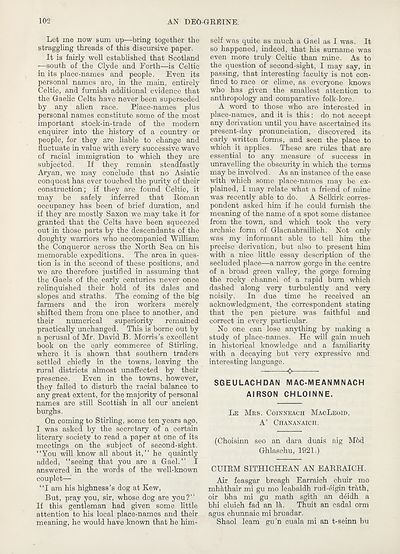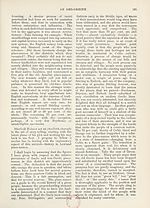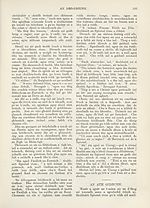An Comunn Gàidhealach Publications > Deo-gréine > Volume 17, October 1921 to September 1922
(110) Page 102
Download files
Complete book:
Individual page:
Thumbnail gallery: Grid view | List view

102
AN DE6-GREINE.
Let me now sum up—bring together the
straggling threads of this discursive paper.
It is fairly well established that Scotland
—south of the Clyde and Forth—is Celtic
in its place-names and people. Even its
personal names are, in the main, entirely
Celtic, and furnish additional evidence that
the Gaelic Celts have never been superseded
by any alien race. Place-names plus
personal names constitute some of the most
important stock-in-trade of the modem
enquirer into the history of a country or
people, for they are liable to change and
fluctuate in value with every successive wave
of racial immigration to which they are
subjected. If they remain steadfastly
Aryan, we may conclude that no Asiatic
conquest has ever touched the purity of their
construction; if they are found Celtic, it
may be safely inferred that Roman
occupancy has been of brief duration, and
if they are mostly Saxon we may take it for
granted that the Celts have been squeezed
out in those parts by the descendants of the
doughty warriors who accompanied William
the Conqueror across the North Sea on his
memorable expeditions. The area in ques¬
tion is in the second of these positions, and
we are therefore justified in assuming that
the Gaels of the early centuries never once
relinquished their hold of its dales and
slopes and straths. The coming of the big
farmers and the iron workers merely
shifted them from one place to another, and
their numerical superiority remained
practically unchanged. This is borne out by
a perusal of Mr. David B. Morris’s excellent
book on the early commerce of Stirling,
where it is shown that southern traders
settled chiefly in the towns, leaving the
rural districts almost unaffected by their
presence. Even in the towns, however,
they failed to disturb the racial balance to
any great extent, for the majority of personal
names are still Scottish in all our ancient
burghs.
On coming to Stirling, some ten years ago,
I was asked by the secretary of a certain
literary society to read a paper at one of its
meetings on the subject of second-sight.
“You will know all about it,’’ he quaintly
added, “seeing that you are a Gael.’’ I
answered in the words of the well-known
couplet—:
“lam his highness’s dog at Kew,
But, pray you, sir, whose dog are you?’’
If this gentleman had given some little
attention to his local place-names and their
meaning, he would have known that he him¬
self was quite as much a Gael as I was. It
so happened, indeed, that his surname was
even more truly Celtic than mine. As to
the question of second-sight, I may say, in
passing, that interesting faculty is not con-
flned to race or clime, as everyone knows
who has given the smallest attention to
anthropology and comparative folk-lore.
A word to those who are interested in
place-names, and it is this: do not accept
any derivation until you have ascertained its
present-day pronunciation, discovered its
early written forms, and seen the place to
which it applies. These are rules that are
essential to any measure of success in
unravelling the obscurity in which the terms
may be involved. As an instance of the ease
with which some place-names may be ex¬
plained, I may relate what a friend of mine
was recently able to do. A Selkirk corres¬
pondent asked him if he could furnish the
meaning of the name of a spot some distance
from the town, and which took the very
archaic form of Glacnabraillich. Not only
was my informant able to tell him the
precise derivation, but also to present him
with a nice little essay description of the
secluded place—a narrow gorge in the centre
of a broad green valley, the gorge forming
the rocky channel of a rapid bum which
dashed along very turbulently and very
noisily. In due time he received an
acknowledgment, the correspondent stating
that the pen picture was faithful and
correct in every particular.
No one can lose anything by making a
study of place-names. He will gain much
in historical knowledge and a familiarity
with a decaying but very expressive and
interesting language.
o
SGEULACHDAN M AC-MEAN MN ACH
AIRSON CHLOINNE.
Le Mrs. Coinneach MacLeoid,
A’ ClIANANAICH.
(Choisinn seo an dara duals aig Mbd
Ghlaschu, 1921.)
CUIRM SITHICHEAN AN EARRAICH.
Air feasgar breagh Earraich chuir mo
mhkthair mi gu mo leabaidh rud-^igin tr&th,
oir bha mi gu math sglth an deidh a
bhi cluich fad an Ik. Thuit an cadal orm
agus chunnaic mi bruadar.
Shaol leam gu’n cuala mi an t-seinn bu
AN DE6-GREINE.
Let me now sum up—bring together the
straggling threads of this discursive paper.
It is fairly well established that Scotland
—south of the Clyde and Forth—is Celtic
in its place-names and people. Even its
personal names are, in the main, entirely
Celtic, and furnish additional evidence that
the Gaelic Celts have never been superseded
by any alien race. Place-names plus
personal names constitute some of the most
important stock-in-trade of the modem
enquirer into the history of a country or
people, for they are liable to change and
fluctuate in value with every successive wave
of racial immigration to which they are
subjected. If they remain steadfastly
Aryan, we may conclude that no Asiatic
conquest has ever touched the purity of their
construction; if they are found Celtic, it
may be safely inferred that Roman
occupancy has been of brief duration, and
if they are mostly Saxon we may take it for
granted that the Celts have been squeezed
out in those parts by the descendants of the
doughty warriors who accompanied William
the Conqueror across the North Sea on his
memorable expeditions. The area in ques¬
tion is in the second of these positions, and
we are therefore justified in assuming that
the Gaels of the early centuries never once
relinquished their hold of its dales and
slopes and straths. The coming of the big
farmers and the iron workers merely
shifted them from one place to another, and
their numerical superiority remained
practically unchanged. This is borne out by
a perusal of Mr. David B. Morris’s excellent
book on the early commerce of Stirling,
where it is shown that southern traders
settled chiefly in the towns, leaving the
rural districts almost unaffected by their
presence. Even in the towns, however,
they failed to disturb the racial balance to
any great extent, for the majority of personal
names are still Scottish in all our ancient
burghs.
On coming to Stirling, some ten years ago,
I was asked by the secretary of a certain
literary society to read a paper at one of its
meetings on the subject of second-sight.
“You will know all about it,’’ he quaintly
added, “seeing that you are a Gael.’’ I
answered in the words of the well-known
couplet—:
“lam his highness’s dog at Kew,
But, pray you, sir, whose dog are you?’’
If this gentleman had given some little
attention to his local place-names and their
meaning, he would have known that he him¬
self was quite as much a Gael as I was. It
so happened, indeed, that his surname was
even more truly Celtic than mine. As to
the question of second-sight, I may say, in
passing, that interesting faculty is not con-
flned to race or clime, as everyone knows
who has given the smallest attention to
anthropology and comparative folk-lore.
A word to those who are interested in
place-names, and it is this: do not accept
any derivation until you have ascertained its
present-day pronunciation, discovered its
early written forms, and seen the place to
which it applies. These are rules that are
essential to any measure of success in
unravelling the obscurity in which the terms
may be involved. As an instance of the ease
with which some place-names may be ex¬
plained, I may relate what a friend of mine
was recently able to do. A Selkirk corres¬
pondent asked him if he could furnish the
meaning of the name of a spot some distance
from the town, and which took the very
archaic form of Glacnabraillich. Not only
was my informant able to tell him the
precise derivation, but also to present him
with a nice little essay description of the
secluded place—a narrow gorge in the centre
of a broad green valley, the gorge forming
the rocky channel of a rapid bum which
dashed along very turbulently and very
noisily. In due time he received an
acknowledgment, the correspondent stating
that the pen picture was faithful and
correct in every particular.
No one can lose anything by making a
study of place-names. He will gain much
in historical knowledge and a familiarity
with a decaying but very expressive and
interesting language.
o
SGEULACHDAN M AC-MEAN MN ACH
AIRSON CHLOINNE.
Le Mrs. Coinneach MacLeoid,
A’ ClIANANAICH.
(Choisinn seo an dara duals aig Mbd
Ghlaschu, 1921.)
CUIRM SITHICHEAN AN EARRAICH.
Air feasgar breagh Earraich chuir mo
mhkthair mi gu mo leabaidh rud-^igin tr&th,
oir bha mi gu math sglth an deidh a
bhi cluich fad an Ik. Thuit an cadal orm
agus chunnaic mi bruadar.
Shaol leam gu’n cuala mi an t-seinn bu
Set display mode to:
![]() Universal Viewer |
Universal Viewer | ![]() Mirador |
Large image | Transcription
Mirador |
Large image | Transcription
| An Comunn Gàidhealach > An Comunn Gàidhealach Publications > Deo-gréine > Volume 17, October 1921 to September 1922 > (110) Page 102 |
|---|
| Permanent URL | https://digital.nls.uk/127171293 |
|---|
| Description | Leabhar 17, Treasamh Mios an Fhoghair 1921 gu Dara Mìos an Fhoghair 1922 |
|---|---|
| Attribution and copyright: |
|
| Description | This contains items published by An Comunn, which are not specifically Mòd-related. It includes journals, annual reports and corporate documents, policy statements, educational resources and published plays and literature. It is arranged alphabetically by title. |
|---|
| Description | A collection of over 400 items published by An Comunn Gàidhealach, the organisation which promotes Gaelic language and culture and organises the Royal National Mòd. Dating from 1891 up to the present day, the collection includes journals and newspapers, annual reports, educational materials, national Mòd programmes, published Mòd literature and music. |
|---|---|
| Additional NLS resources: |
|

